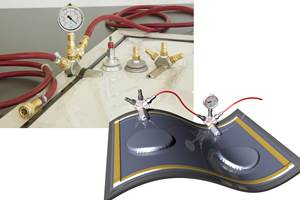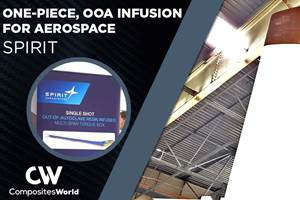Beyond adaptation: Real metamorphosis
Guest columnist Jim Shobert, the CEO of Polygon Company (Walkerton, Ind.), looks at the massive metamorphosis that have swept the composites industry and muses on the nature of the industry's mission.
It has been exciting to witness and experience, first-hand, the metamorphosis of our industry. As part of a second-generation composites family in the 1960s, I literally grew up running a pultrusion machine and doing something we called filament weaving, which was, in reality, braiding — a textile process we wanted to keep secret from potential competitors.
Our father had been part of a group of civilian scientists working at Wright-Patterson Air Force Base (Ohio) during WWII, developing cotton phenolic prepreg fabrics to mold into structural components for such things as nonmagnetic land mine detectors. We were the poster children for “Better Living through Creative Chemistry”: We had lunch perched on drums of methylene chloride after rinsing our hands in styrene. (Disposable gloves were for the faint of heart.) We even ruined a home oven or two curing some epoxy laminates. Afterward, mom couldn’t use them because subsequent cakes and pies all had that anhydrite aftertaste.
The word metamorphosis is typically used to convey the concepts of transformation, change or adaptation — all of which have been witnessed as we have watched the industry mature. However, if we probe the Greek a bit deeper, metamorphosis more precisely suggests evolving or changing into something uniquely better. If we think in terms of composites, there is a double meaning: In macro terms, as we review the past 50 to 60 years in the composite industry, we really are experiencing the structural transformation of an entire spectrum of processes, applications and markets served: What once was primarily an art has become a real science. All of this has been positive and good, as several large corporations learned in the 1970s after purchasing family-owned composites businesses only to discover that when the weather changed, so did their output of quality parts. Still more art than science, at that time.
Early on, most of us were chasing — at that time, under the moniker of reinforced plastics — the same applications, in recreational, insulated electrical or corrosion-resistant product markets. It’s clear, now, that we also were secretly inventing the same process technologies, vainly attempting to distinguish ourselves from our competitors and, in doing so, inadvertently slowing up the entire adaptation process. Today, a plethora of markets and applications have developed, demonstrating the real possibilities and capabilities of composites. Growth in the numbers of market sectors and end-products continues to advance because the composites industry has learned that cooperative development is the better way to earn market acceptance. Now, public/private partnerships that include universities and input from trade associations are at the forefront of composites science.
We have always tried to be somewhat contrarian in our approach as we exploited these new possibilities. Early, most composite fabricators positioned their products as metal replacements. The real essence of composite manufacturing isn’t replacing metallic constituents, but radically re-imagining those constituents through the creative use and manipulation of individual fibers and polymer resin systems. But many found it difficult to see the composites enterprise as a transformational culture. This was manifested years ago when we exhibited at the Chicago Design Engineering Exposition. A visiting competitor came by our booth and asked why we were displaying at that trade show venue rather than seeking market share at the SPI (Society of the Plastics Industry) exposition. I replied that I merely wanted to be where people came looking for aluminum, stainless steel and other metals so we could capture a portion of their mindshare. The next year, this individual also had a booth at the Design Engineering Exposition. The more we can grasp, from an industry-wide perspective, that our mission is to provide solutions, not duplicate metal parts, the more successful we all will be.
An exciting but somewhat counterintuitive aspect of this metamorphosis is that electronic sensing technologies can be incorporated into the laminate cross section. These can range from sensing conductive changes in the polymer base to actual embedded circuitry in the form of conductive films or fibers, i.e., carbon fibers or — taking a page out of the competition’s playbook — metallic fibers. We, in fact, pioneered in composite tubing, a laminate in which there are alternating, discrete thicknesses of electrically conductive and insulating materials. In an insulated/conductive/insulated laminate, for example, insulating layers protect the conductive layer, allowing it to sense a metal object’s movement through the tube by measuring changes in the magnetic field within the tube. This is something the metals industry can do only by affixing or machining something into place externally — an additional step. In a world still immersed in metal paradigms, such capabilities represent real, essential change.
Today, we’ve eliminated the methylene chloride, we don’t bathe in styrene and only occasionally use the lunchroom microwave to postcure a part. A lot has changed, but one constant remains — an overwhelming opportunity for even greater composites metamorphosis.
Related Content
Novel composite technology replaces welded joints in tubular structures
The Tree Composites TC-joint replaces traditional welding in jacket foundations for offshore wind turbine generator applications, advancing the world’s quest for fast, sustainable energy deployment.
Read MoreSmartValves offer improvements over traditional vacuum bag ports
Developed to resolve tilting and close-off issues, SmartValves eliminate cutting through vacuum bags while offering reduced process time and maintenance.
Read MorePlant tour: Albany Engineered Composites, Rochester, N.H., U.S.
Efficient, high-quality, well-controlled composites manufacturing at volume is the mantra for this 3D weaving specialist.
Read MoreVIDEO: One-Piece, OOA Infusion for Aerospace Composites
Tier-1 aerostructures manufacturer Spirit AeroSystems developed an out-of-autoclave (OOA), one-shot resin infusion process to reduce weight, labor and fasteners for a multi-spar aircraft torque box.
Read MoreRead Next
VIDEO: High-volume processing for fiberglass components
Cannon Ergos, a company specializing in high-ton presses and equipment for composites fabrication and plastics processing, displayed automotive and industrial components at CAMX 2024.
Read More“Structured air” TPS safeguards composite structures
Powered by an 85% air/15% pure polyimide aerogel, Blueshift’s novel material system protects structures during transient thermal events from -200°C to beyond 2400°C for rockets, battery boxes and more.
Read MoreAll-recycled, needle-punched nonwoven CFRP slashes carbon footprint of Formula 2 seat
Dallara and Tenowo collaborate to produce a race-ready Formula 2 seat using recycled carbon fiber, reducing CO2 emissions by 97.5% compared to virgin materials.
Read More











.jpg;maxWidth=300;quality=90)










